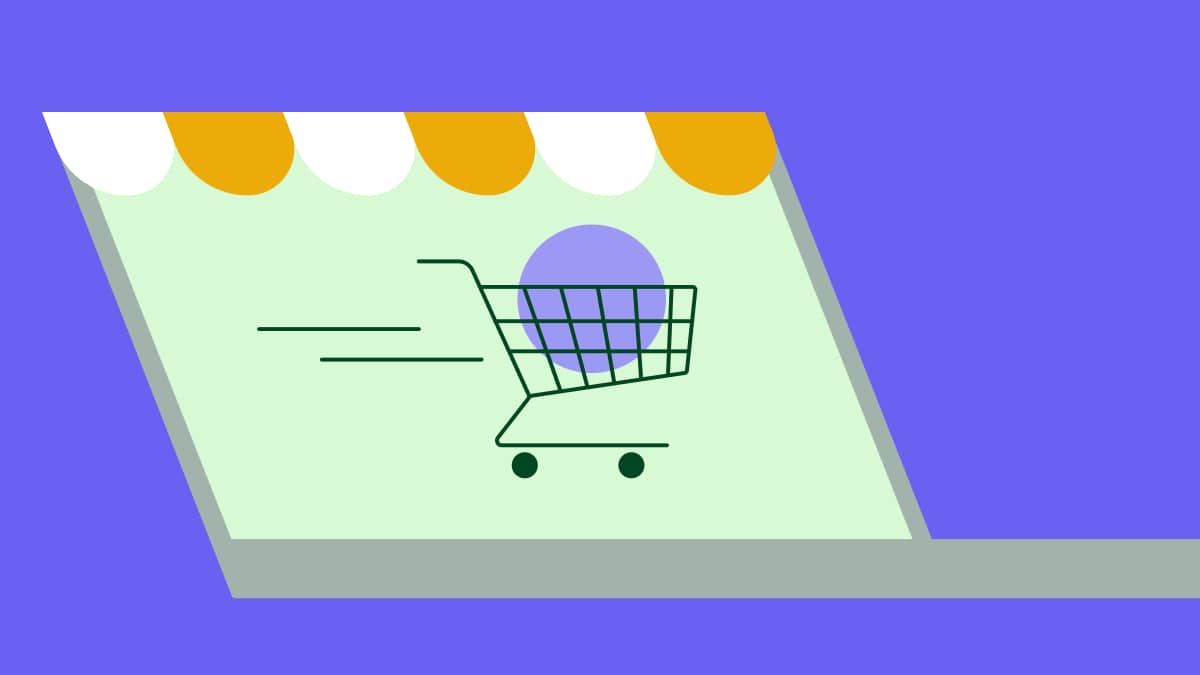Selling has moved online, and many small business owners worry they’re falling behind. Traditional sales methods still work, but they’re no longer enough on their own.
A digital sales strategy helps you find buyers, build relationships and close more deals online. You keep doing what you’re good at, but technology enables you to reach more people and work more efficiently.
In this article, you’ll learn what digital sales means and how to build a winning strategy. You’ll also see how Pipedrive helps you transition and boost your sales outcomes.
What is digital sales?
Digital sales means using the internet and online tools to find and sell to customers. Instead of phone calls or sales meetings, you use websites, social media, email and software to make sales.
These tools handle repetitive tasks, organize customer information and help you stay in touch with sales prospects.
The main components of digital sales include:
Digital sales component | What it is (with examples) |
Tools that help you communicate with prospects over the internet. Examples: email marketing, live chat, digital sales rooms and messaging apps. | |
Software that stores your customer data, tracks interactions and reminds you when to follow up with leads. Examples: cloud-based CRM software like Pipedrive. | |
Making online content that attracts customers and shows how you solve their problems. Examples: blog posts, newsletters, video marketing, how-to guides and social media content. | |
Using social media platforms to share helpful content and build relationships online. Examples: creating brand awareness on LinkedIn, Facebook, Instagram and TikTok. | |
Tools that show you which of your digital marketing strategies work best and which customers are most likely to buy. Examples: Google Analytics for web traffic, social media insights and sales reporting tools from CRM systems. |
How you use these tools depends on whether you sell to individual customers or other businesses.
Businesses selling to customers (B2C sales) use digital tools for quick sales, while companies selling to other businesses (B2B sales) use them to build long-term relationships with decision-makers.
These parts work together as your digital sales system. Combining them will make you grow your business faster than using in-person methods alone.
5 key benefits of a digital sales strategy
Digital sales make you more effective by giving you better information about your customers and more ways to reach them.
Here are five ways a digital sales enablement strategy benefits your business.
1. Reach more customers, faster
Digital sales break down geographical barriers. You connect with potential customers beyond your local area without travelling or opening new physical locations.
With a broader reach, your sales organization can find more opportunities.
Pipedrive in action: Ari Motors used Pipedrive’s automations and lead generation features to bring its electric cars to customers all over Europe. With Pipedrive, Ari Motors could handle more customers and quickly increased sales by 10 times.
Instead of limiting yourself to walk-in customers, you serve clients and sell products through digital platforms. Think of a consulting firm that now works with clients via video calls and digital contracts.
Geographic limitations no longer constrain your sales potential.
2. Understand your customers and provide better solutions
Simple marketing metrics like email clicks and website visits help you understand your customers’ buying habits and what content they respond to. This information helps your team offer customers the right solutions.
An e-commerce retailer, for example, can track popular product pages and send targeted offers for those items.
Pipedrive in action: Leni, Leon & die Luchse overhauled its workflow with Pipedrive to better manage leads and customer data. With centralized information, its sales reps had clearer insights into customer needs and could tailor outreach more effectively.
Every click, view and interaction tells you something valuable about your prospects, revealing patterns in customer behavior that were previously invisible.
3. Boost sales team productivity
For small teams, every minute counts. Digital sales tools automate day-to-day tasks, freeing up your time for higher-value activities.
An automated email series nurtures leads while your team focuses on closing sales. CRMs remind you when to follow up, ensuring no opportunity falls through the cracks.
A real estate agent might use automated scheduling software to book property viewings, while marketing automation sends updates about new listings to interested buyers.
Pipedrive in action: Hanse Mondial could process twice as many leads without needing more staff. Its sales team could work five times faster thanks to Pipedrive’s automations and smart integrations.
Smart tool investments pay for themselves through eliminated overhead costs. When technology handles repetitive work, your team can focus on closing deals.
4. Reduce sales costs (and increase profitability)
Tools require an initial investment, but a good digital selling plan saves you money in the long run.
Small businesses save expenses on travel, printing marketing materials and maintaining physical office spaces.
For example, you can showcase your product portfolio online instead of printing brochures. Likewise, you can use video calls for client meetings rather than travelling across town for every consultation.
Pipedrive in action: Visionair Media saved 75% in CRM costs by switching to Pipedrive. Its transition during the COVID-19 pandemic helped streamline operations and reduce overall costs, showing how the right tools can boost profitability.
Digital operations eliminate many traditional overhead expenses that drain profit margins. The financial benefits extend far beyond the initial tool investment.
5. Improve the customer experience
Digital shopping is often faster, more convenient and more consistent than in-person shopping. Customers can reach you easily through their preferred channels and get quick responses.
Online booking systems let customers schedule appointments outside business hours. Live chat on your website answers questions instantly instead of making people wait for phone calls.
This convenience builds customer loyalty.
Pipedrive in action: DashThis used Pipedrive to create an unbeatable customer experience (CX). With a clear view of its sales pipeline, DashThis could provide better service and reduce customer churn rates.
Modern customers expect convenience and instant responses across all touchpoints.
Rather than forcing customers to call during business hours or wait days for responses, you provide immediate assistance and 24/7 access to your services.
How to transition to digital sales (and how Pipedrive helps)
Moving to digital sales can seem like a massive project, but it’s achievable when you break it down into clear steps.
Follow this roadmap to build a powerful digital sales system for your small business.
1. Map your starting point and pick a target
Before building something new, you need a blueprint of what you already have. A quick check-up helps you see what’s working, where you get stuck and what tasks take the most time.
Start by mapping out your entire customer journey, from when a person first hears about your company to the final sale. Ask yourself:
Where do your leads come from now?
What’s your average sales cycle?
Where do deals tend to fall through?
Which tasks take up the most time?
Next, examine digital sales data and check metrics like your conversion rate, time-to-close and win/loss ratio. If you’re not tracking these, now’s the time to start.
Once you understand your baseline, you can set meaningful goals, which might include:
Sales goals | What you want to achieve |
Goal #1 | Shorten the sales cycle by automating lead follow-up |
Goal #2 | Improve response time using live chat or email sequences |
Goal #3 | Increase conversion rates through better lead qualification |
Goal #4 | Grow total sales by expanding into new online channels |
Use the SMART framework to make your sales goals specific, measurable, achievable, relevant and time-bound.
How Pipedrive helps
Pipedrive’s visual pipelines help you map your current sales process. Create stages matching the steps you take to close a deal and get a quick workflow overview.
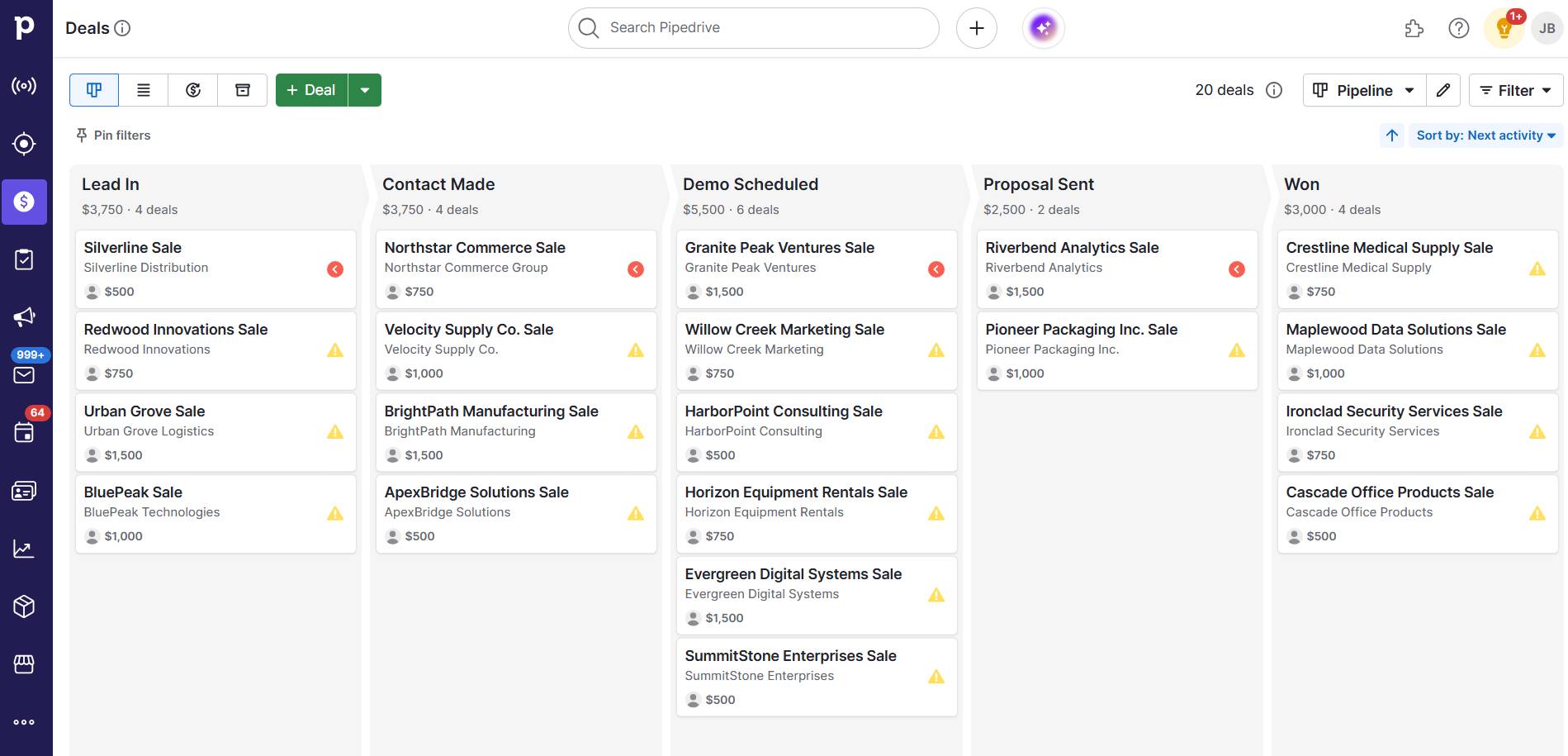
You can create a new pipeline to test your digital sales ideas and see how they compare to your old methods.
Pipedrive also helps you set and track goals. With Pipedrive’s Activities and Goals feature, you can measure team performance on activities, revenue, deals won and more.
Set a goal like “close 10 deals from social media leads per month” and Pipedrive will automatically update you on your progress, so you know how close you are to hitting the target.
2. Choose the proper digital channels
You don’t need to be on every social media platform or run ads everywhere. The key is to be present on the channels where your ideal customers spend their time.
First, define your buyer persona by thinking about your best customers:
Where do they go to research solutions? (e.g., Google, YouTube, LinkedIn)
What kind of content do they engage with? (e.g., short videos, detailed blog posts, podcasts)
How do they prefer to communicate? (e.g., email, chat, texting apps)
When you have a solid understanding, match your channels to customer behavior:
Digital channel | What it’s best for |
Nurturing leads, re-engaging past prospects and follow-ups | |
Social media | Building brand awareness, sharing content and engaging with customers directly |
Live chat and messaging apps | Providing instant customer support and answering pre-sale questions |
Attracting web traffic and educating leads about your offerings | |
Video and webinars | Demonstrating expertise and building trust for high-value sales |
You can pick more than one, but you should prioritize based on your audience and goals.
For example, a B2B digital sales firm might focus on LinkedIn and email nurture sequences, while a direct-to-consumer product brand might focus on Instagram, TikTok and website chat.
Start with one or two channels you’re confident your audience uses. Build a presence, test your messaging and track your results.
Once you’re seeing consistent engagement, consider adding more.
How Pipedrive helps
Pipedrive helps you capture leads from the channels you choose. Add Pipedrive’s LeadBooster feature to your plan and engage visitors from multiple digital entry points:
Chatbot. Greet website visitors, qualify them and capture lead info.
Web Chat. Let your team answer questions in real time.
Web Forms. Add lead-capturing forms to landing pages or blog posts.
Prospector. Discover and contact verified outbound leads based on ideal criteria.
You can also integrate your CRM with popular tools like Facebook Ads and LinkedIn forms to pull leads straight into Pipedrive.
3. Build your digital sales toolkit
Your tools are the engine of your digital sales strategy. A well-chosen toolkit supports the core activities your team performs every day.
Here’s a breakdown of what you’ll need to do and the tools that can help at each step:
Sales task | Tools that integrate with Pipedrive |
Capturing and qualifying leads |
|
Tracking interactions and deals |
|
Communicating with prospects | |
Automating follow-ups |
|
Generating quotes and proposals |
|
Analyzing performance |
|
Start small and focus on tools that reduce manual work, talk to each other and scale with your team.
How Pipedrive helps
Pipedrive is the central hub of your digital sales toolkit. A lot of what you need is already built in or available as add-ons.
If you rely on other tools, you can easily connect them. Pipedrive integrates with hundreds of apps on the Pipedrive Marketplace, so they sync data without adding to your team’s workload.
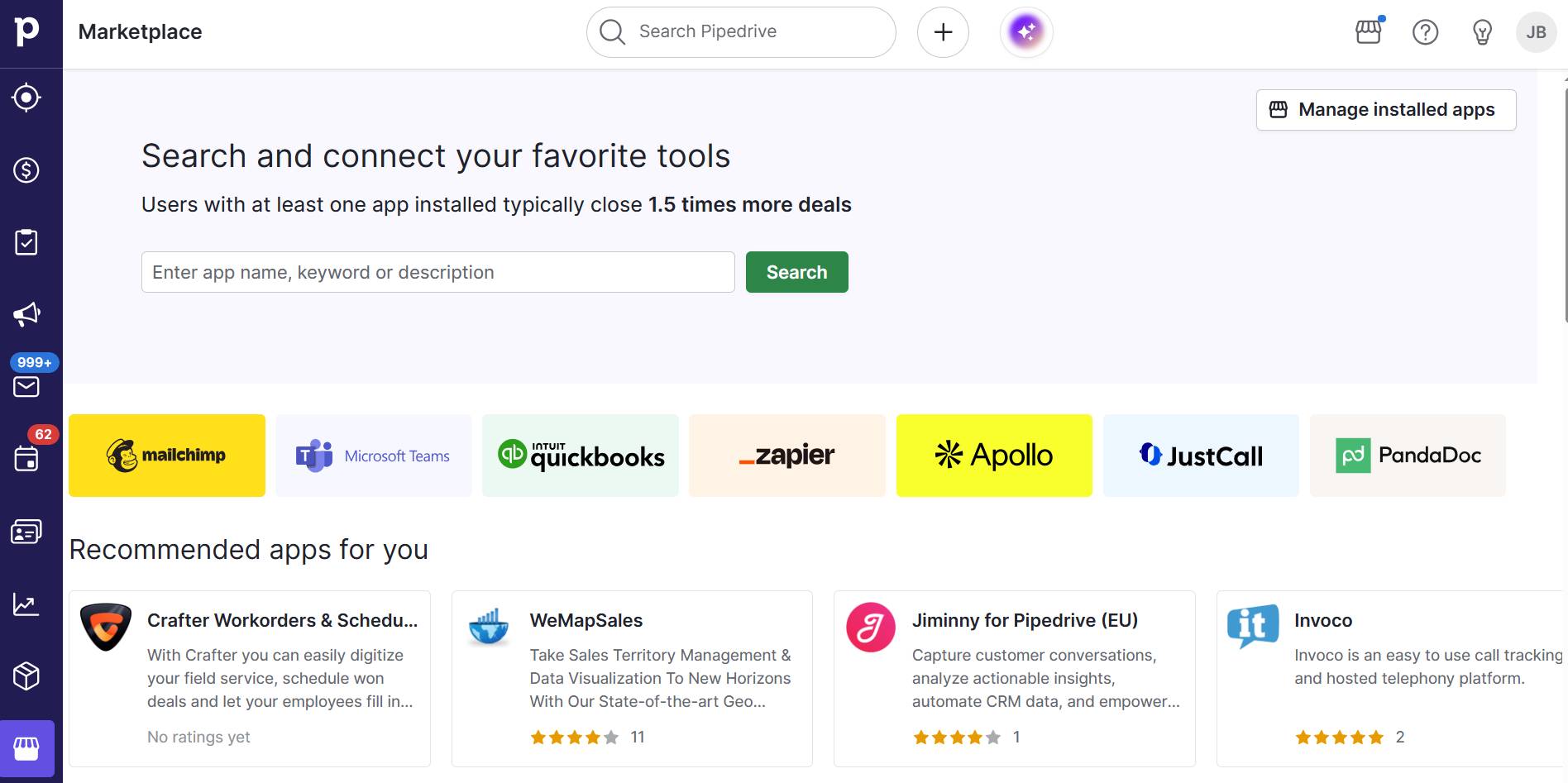
For example, say a lead fills out a form on your website. The form sends this info to Pipedrive, which creates a deal and sends your team a notification – no manual data entry required.
Pipedrive brings your sales stack together so you spend less time switching tools. This approach keeps your system lean.
4. Create content that sells for you
Good content draws customers in. Instead of cold calling, you offer help first and build trust.
By sharing your expertise, you stay top of mind until they’re ready to take the next step and make a purchase.
Start by answering your customers’ most common questions:
Create short blog posts or how-to guides
Record simple videos explaining how your product or service solves a specific problem
Develop a customer story or testimonial showing how you helped another customer succeed
Offer a downloadable checklist or template in exchange for an email address
If you’re a service business, you might attract leads with a blog post and follow up with an email series that leads to a consultation. If you sell products, you might guide people from a how-to video to a sales demo or call.
Share this content on the digital channels you chose in step two. The goal is to be helpful and earn your target audience’s attention.
How Pipedrive helps
Pipedrive manages the leads your marketing content generates. You track what content a lead has seen by adding it to their notes or using custom fields.
If someone downloads your pricing guide, that’s a sign they’re considering buying. Your sales team sees that in the lead’s profile and follows up accordingly.

You can also build simple email flows that send helpful content to new leads over time.
For example, after someone fills out a form on your site, you can send them a case study. A few days later, you send a short “how it works” video, then a reminder to book a call.
5. Mix your digital and traditional sales strategies
As you move into digital sales, don’t overlook your offline sales. Your best results come when digital tools support the relationships your team already has.
Think about how digital and traditional sales tactics work together:
Use email to warm up a lead before you make a phone call
Use a scheduling tool to let prospects book a meeting without back-and-forth emails
Follow up a face-to-face meeting with a digital summary and relevant resources
Make sure your customer data flows between digital and traditional channels. When information is scattered, customers end up repeating themselves, which hurts trust.
How Pipedrive helps
Pipedrive gives you a 360-degree view of every contact. You can sync your email to track conversations and log notes in each deal or contact profile.
You can also use the built-in Scheduler feature to let prospects book meetings in your calendar. It creates an activity for the meeting and links it to the correct contact and deal, bridging your digital and traditional sales efforts.
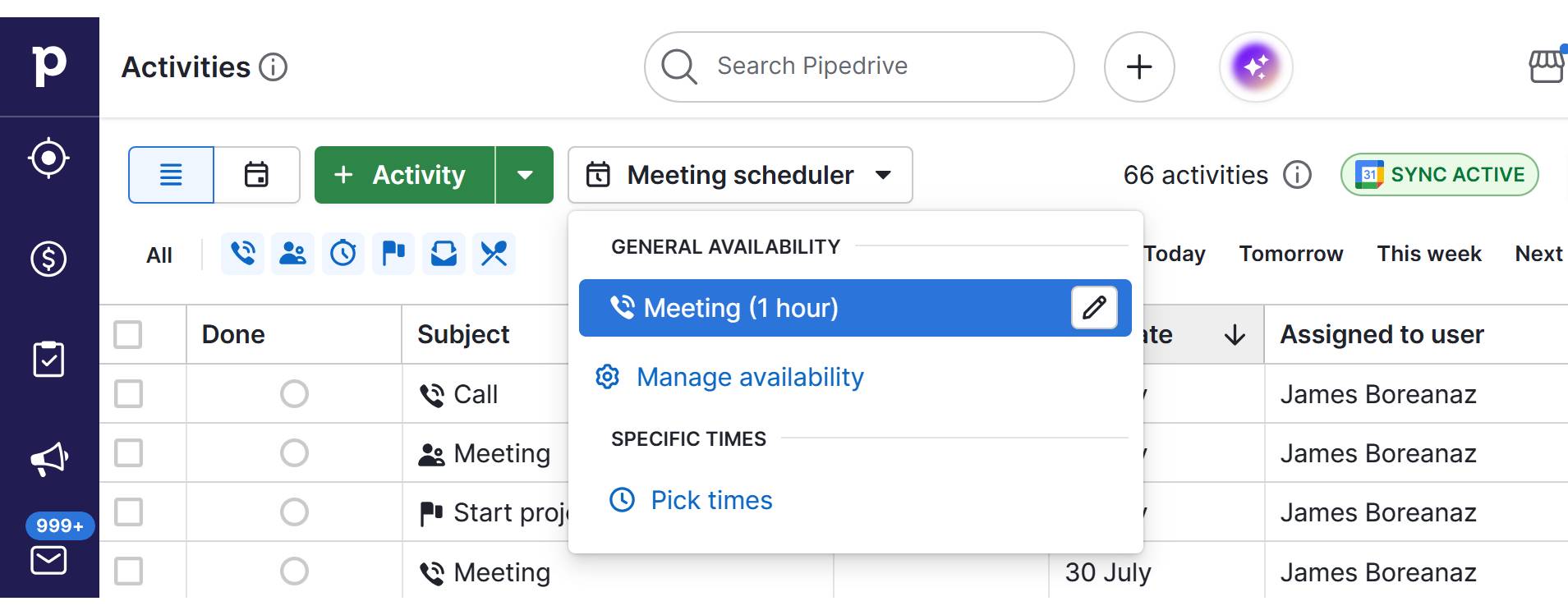
With Pipedrive’s mobile app, your team can update deals and customer info in real time, even when visiting clients or at events.
6. Put repetitive tasks on autopilot
Automation is your secret weapon for scaling your small business. It handles the time-consuming admin work, freeing your sales professionals to focus on building relationships.
Beyond just saving time, automation creates a more consistent customer experience. You can handle more leads with the same team, making your business more profitable.
To start, look for patterns in your daily work, using these two components:
Triggers. An event that kicks off an automated process, like adding a new lead or moving a deal to a new stage.
Actions. What you want to happen after a trigger occurs, like sending a notification or creating a task for a team member.
Start by automating simple tasks like sending a welcome email to every new lead from your website – then build more automations as you need them.
How Pipedrive helps
Pipedrive’s Automations feature lets you build trigger-and-action rules without coding.
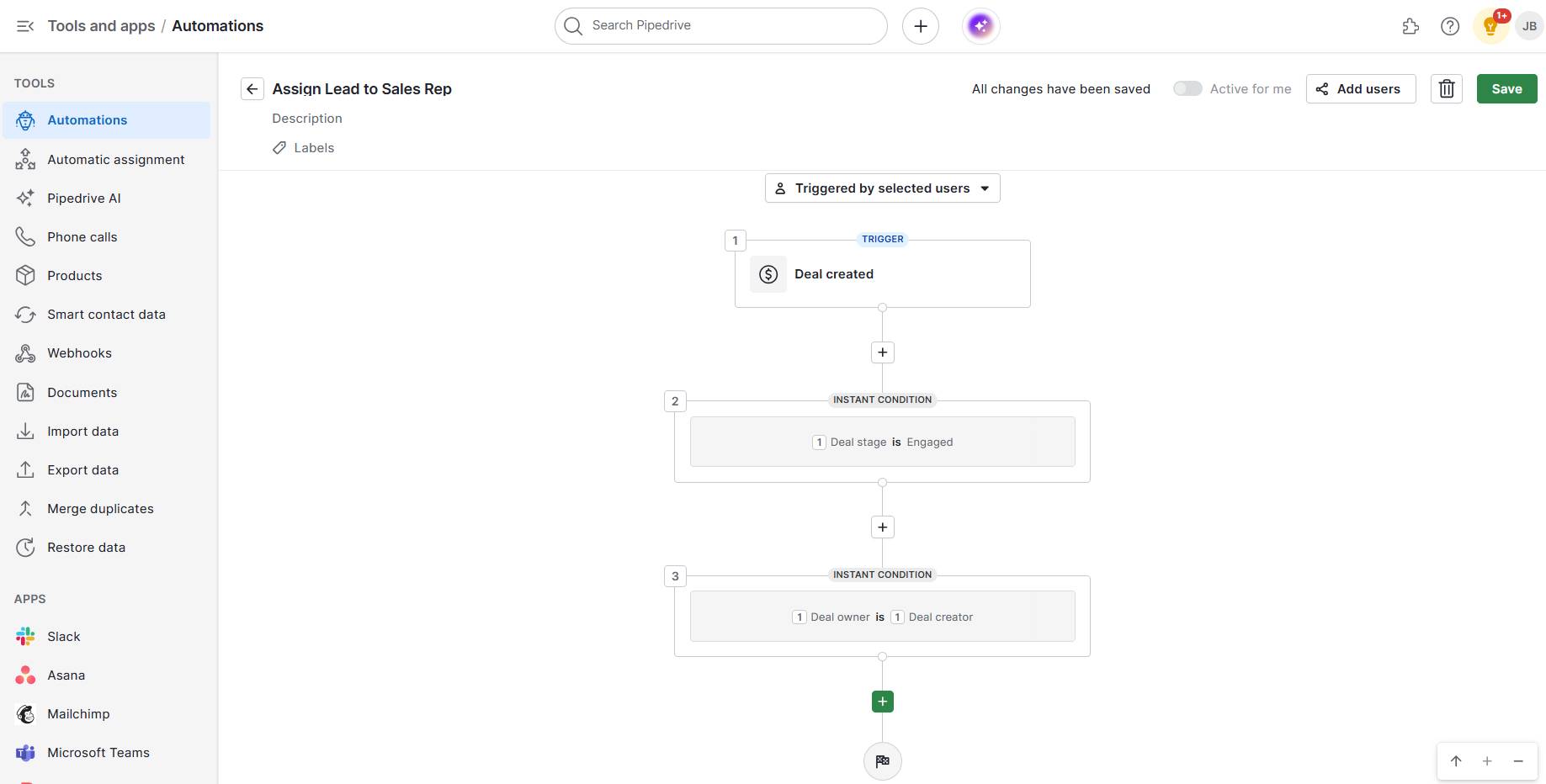
One everyday use case is preventing deals from going cold. Create a rule that says, “If a deal has had no new activity for 10 days, create a high-priority task for the deal owner to check in.” That salesperson will get a notification, preventing deals from slipping away.
This feature can automate nearly any task in your sales cycle, such as lead assignment, email sequences and deal stage updates.
7. Use data to make smarter sales decisions
Tracking your results helps you make smart business decisions and focus on what works.
Start with a few key performance indicators (KPIs) that give you a high-level view:
Digital sales KPIs | Questions to ask |
Deal metrics | What is your average win rate and sales velocity? What is the average size of a won deal? |
Activity metrics | How many calls, emails or meetings does it take to win a deal? Is your team putting in enough effort? |
Lead source performance | Which of your sales channels are generating the most valuable leads? |
Look for trends and find reasons for them. The answers will highlight your most significant sales opportunities.
For example, say deals are stalling at the proposal stage and you think a better proposal template and follow-up will help.
Implement the change, then go back to step one and measure the impact. The goal is to create a continuous improvement loop: measure, analyze and optimize.
How Pipedrive helps
Pipedrive’s Insights and Reports dashboards help you optimize sales performance. You can move beyond simple data and get actionable insights.
Use the main dashboard to see your win rate, loss rate and deal velocity. Filter by different periods to identify trends and spot where deals are stuck in your pipeline.
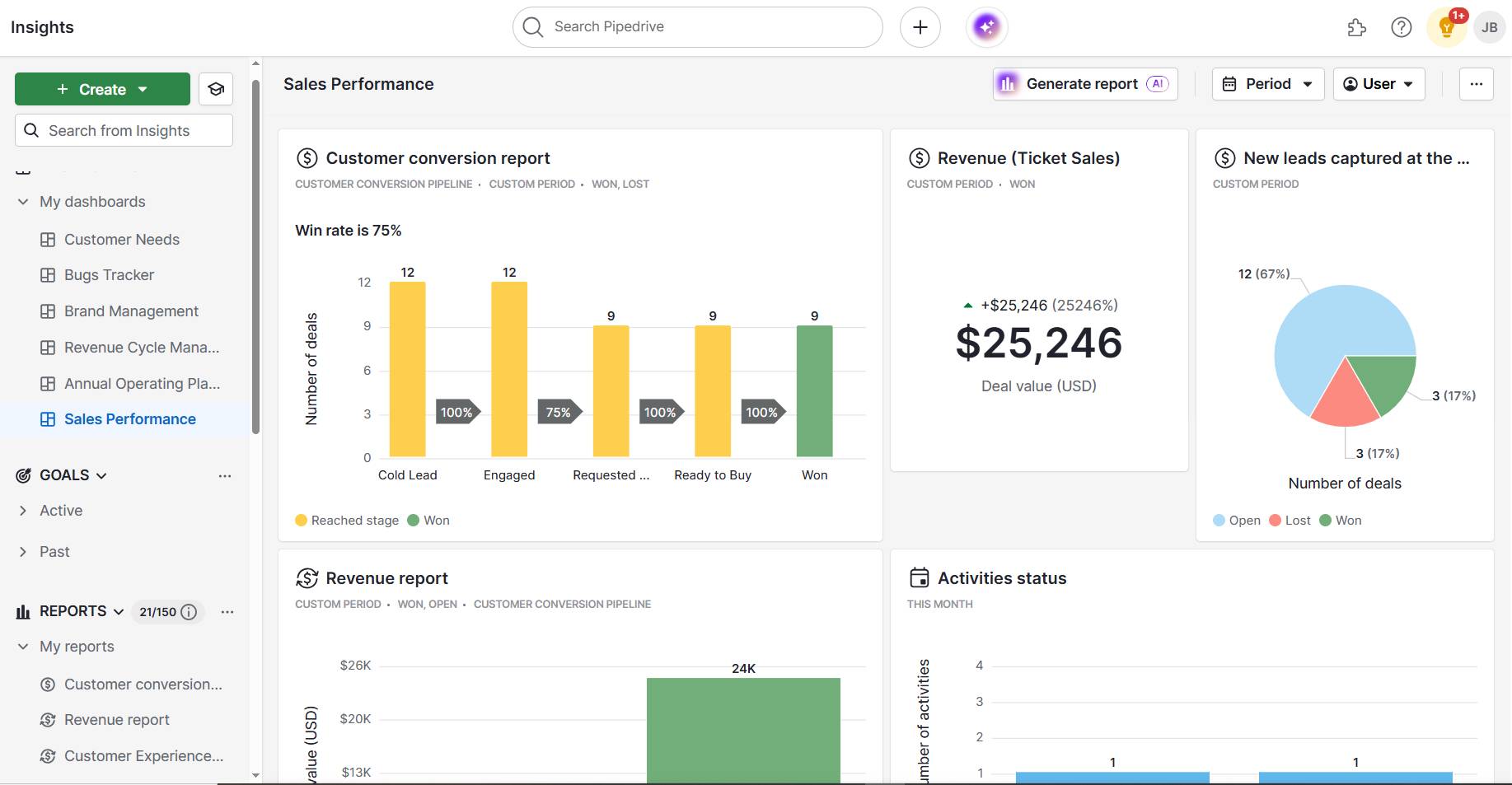
Create reports to see the volume of activities your team is completing. Compare activity metrics (e.g., calls made) with performance metrics (e.g., deals won) to see which activities lead to the best results.
You can also use reports to analyze lead source performance. If you see that leads from Google Ads have a 25% conversion rate, while trade show leads only have a 5% rate, you know to focus on Google next time.
Get organized with your free sales pipeline excel template
Final thoughts
A strong digital sales strategy transforms how you do business. It helps you reach more customers, understand their needs and save valuable time.
Start small, stay organized and build momentum from there.
See how Pipedrive brings your entire digital sales process together in one place. Start your free 14-day trial to find more leads, streamline your workflows and close deals faster.
